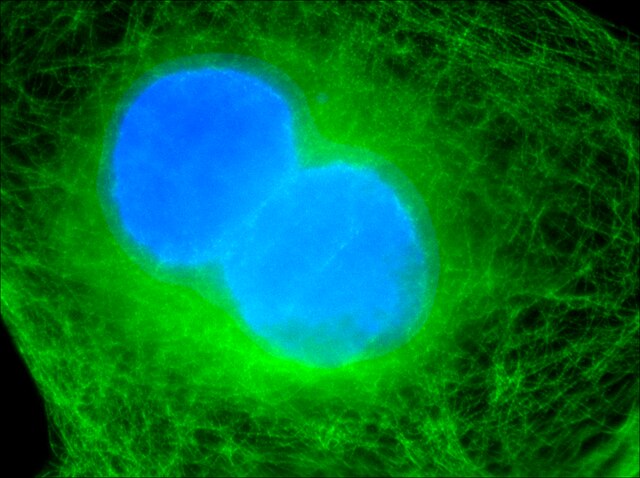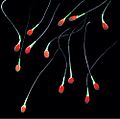Pokretljivost
From Wikipedia, the free encyclopedia
Remove ads
Pokretljivost je sposobnost organizama da se samostalno kreće, koristeći metaboličku energiju. Ovaj termin uključuje i pokretljivost unutarćelijskih struktura i organela.

Sve ćelije mogu se smatrati pokretnima jer ili se kreću u cjelini ili imaju sposobnost podjele u dvije nove ćerke.
Podjela citoplazme, poznata kao citokineza, prati telofazu. Tokom dijeljenja, ćelijski organele poput mitohondrija i hloroplasta ravnomjerno se raspoređuju u dvije novonastale ćelije.
U životinjskim ćelijama podjela se vrši "uvlačenjem" plazmatske membrane na ekvatoru vretena, "štipanjem" citoplazme na pola
U biljnim ćelijama, Golgijev aparat formira vezikule od novih materijala ćelijskog zida koji se skupljaju duž linije ekvatora diobenog vretena, poznatog kao ćelijska ploča.
Ovdje se vezikule spajaju, formirajući nove plazmamembrane i ćelijske zidove između dvije ćelije [1]
Remove ads
Definicije
Pokretljivosti može se suprotstaviti sesilnost, stanje organizama koji ne posjeduju sredstva za samopokretljivost i koji su obično nepokretni. Pokretljivost se razlikuje od kretanja, sposobnosti nečega da se premjesti sa jednog na drugo mjesto. Termin pokretljivost uključuje i pokretljivost i kretanje; sesilni organizmi, uključujući biljke i gljive, često imaju pokretne dijelove poput plodova, sjemena ili spora koje mogu raspršiti drugi agensi poput vjetra, vode ili drugih organizama.[2]
Pokretljivost je genetički određena,[3] ali mogu uticati i okolinski faktori, kao što su toksini. Nervni i mišićnoskeletni sistem omogučavaju glavninu pokretljivosti sisara.[4][5][6]
Pored životinjske lokomocije, većina životinja su pokretne, mada su neke i skretanja, opisano kao da imaju pasivnu pokretljivost. Mnoge bakterije i drugi mikroorganizmi i višećelijski organizmi su pokretni; neki mehanizmi protoka tečnosti u višećelijskim organima i tkivima takođe se smatraju primerima pokretljivosti, kao i kod peristaltičke pokretljivosti gastrointestinalnog trakta. Pokretne morske životinje obično se nazivaju slobodno plivajućim,[7][8][9] a pokretni neparazitski organizmi nazivaju se slobodno živećim.[10]
Remove ads
Ćelijska razina
Ovaj video snima obojene citoskelete iz presjeka lista Arabidopsis thaliana .[11]
Na ćelijskom nivou postoje različiti načini kretanja:
- pokretljivost bičevima, pokreti slični plivanju ( naprimjer kod Spermatozoa, podstaknuto redovitim mahanjem njihovih bičeva, ili kod bakterije E. coli, koja pliva okrećući spiralni prokariotski bič)
- ameboidni pokret, pokret poput puzanja, koji također omogućava plivanje [12][13]
- klizanje
- ronjenje
- trzanje, oblik pokretljivosti koji bakterije koriste za puzanje po površinama pomoću grabljastih filamenata pod nazivom pili tip IV.
- filopodije, omogućava kretanje aksonskih konusa rasta .[14]
Mnoge ćelije nisu pokretne na 37 °C, naprimjer kod Klebsiella pneumoniae i Shigella ili pod određenim okolnostima kao što je Yersinia pestis.
Remove ads
Pokreti
- Vidi
- Taksija
Aktivnostu koje se percipiraju kao pokreti mogu biti:
- duž hemijskog gradijenta (hemotaksija)
- duž gradijenta temperature (termotaksija)
- duž svjetlosnog gradijenta (fototaksija)
- duž linije magnetnog polja (magnetotaksija)
- duž električnog polja (galvanotaksija)
- duž pravca gravitaciijske sile (gravitaksija)
- duž gradijenta krutosti (vidi durotaksija)
- duž gradijenta ćelijskih mjesta prijanjanja (haptotaksija)
- duž ostalih ćelija ili biopolimera
- Mišići daju sposobnost voljnog i nehotičnog kretanja kao pri mišićnim, spazmima i refleksnim radnjama. Na nivou mišićnog sistema, pokretljivost je sinonim za kretanje životinja.[15][16]
- Većina spermatozoida ima jedan bič koji im pomaže u plivanju. Obloge grlića maternice, maternica i jajovodi ženskog reproduktivnog sistema imaju važniju ulogu u transportu sperme do jajne ćelije.
- Rekordne brzine koje postižu, gepardi duguju u velikoj mjeri pokretljivosti njihovih mišića.
- Izdanci biljaka se kreću rastući prema svjetlosti. Ovo je poznato kao pozitivni fototropizam. Korijeni rastu dalje od svetlosti. Ovo je poznato kao negativni fototropizam.
- Monociti i makrofagi imunskog sistema gutaju bakterije širenjem pseudopodija. Ovaj crtani film nije tačan prikaz fagocitoze.
- Pokretljivost na potćelijskom nivou. Prikaz translacije – pokretni molekulski nanoskopski proces pomoću dinamike proteina.
Također pogledajte
Reference
Wikiwand - on
Seamless Wikipedia browsing. On steroids.
Remove ads






